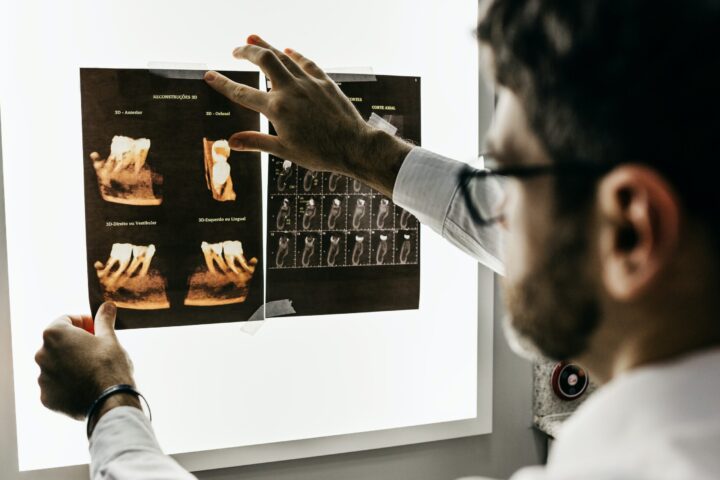Predictive analytics is transforming healthcare by enabling doctors and healthcare providers to forecast health outcomes with greater accuracy. At the heart of this transformation is artificial intelligence (AI). AI is powering predictive analytics by processing vast amounts of data, identifying patterns, and making predictions that would be impossible for humans to achieve on their own.
In this post, we’ll explore how AI is being used in predictive analytics to improve health outcomes, the technology behind it, the benefits and challenges, and what the future might hold. By the end, you’ll have a clear understanding of how AI is revolutionizing healthcare through predictive analytics.
What Is Predictive Analytics in Healthcare?
Before diving into AI’s role, it’s important to understand what predictive analytics is. Predictive analytics involves using historical data to make predictions about future outcomes. In healthcare, this means analyzing patient data to predict things like disease progression, treatment response, or the likelihood of developing a particular condition.
Predictive analytics can help doctors make more informed decisions, tailor treatments to individual patients, and improve overall health outcomes.
For example, a doctor might use predictive analytics to estimate the risk of a patient developing heart disease based on their medical history, lifestyle, and genetic factors. With this information, the doctor can take preventive measures, such as recommending lifestyle changes or prescribing medication, to reduce the patient’s risk.


The Role of AI in Predictive Analytics
AI plays a critical role in predictive analytics by enhancing the ability to process and analyze large datasets. Traditional statistical methods have limitations when it comes to handling complex, high-dimensional data. AI, particularly machine learning, can overcome these limitations by learning from data and improving its predictions over time.
How AI Enhances Predictive Analytics
- Data Processing: AI can process vast amounts of data quickly and accurately. This includes structured data, like lab results, and unstructured data, like doctor’s notes or imaging studies. By processing all this data, AI can create a more complete picture of a patient’s health.
- Pattern Recognition: AI excels at recognizing patterns in data that might not be obvious to humans. For example, AI might identify a correlation between a specific genetic marker and the likelihood of developing a certain disease.
- Personalization: AI can use these patterns to make personalized predictions for individual patients. Instead of relying on general population data, AI can tailor predictions based on a patient’s unique characteristics.
- Continuous Learning: AI systems can continuously learn and improve their predictions as they process more data. This means that over time, AI can become more accurate in forecasting health outcomes.
How AI Collects and Analyzes Data for Predictive Analytics
AI’s ability to predict health outcomes relies on the collection and analysis of large amounts of data. This data comes from various sources and can include everything from medical records to genetic information. Here’s a closer look at how AI collects and analyzes this data.
Types of Data Used in Predictive Analytics
The data used in predictive analytics is diverse and comes from multiple sources:
- Electronic Health Records (EHRs): EHRs contain detailed information about a patient’s medical history, including diagnoses, treatments, lab results, and more. This data is crucial for making accurate predictions.
- Genomic Data: Genomic data includes information about a patient’s DNA. This data can help predict a patient’s risk for certain genetic conditions or how they might respond to specific treatments.
- Lifestyle Data: Lifestyle factors, such as diet, exercise, and smoking habits, play a significant role in health outcomes. AI can analyze this data to predict how lifestyle changes might impact a patient’s health.
- Wearable Devices: Wearable devices, like fitness trackers, collect real-time data on a patient’s physical activity, heart rate, and sleep patterns. This data can be used to monitor and predict health outcomes.
- Imaging Data: Medical imaging, such as X-rays, MRIs, and CT scans, provides valuable information about a patient’s condition. AI can analyze these images to detect early signs of disease or monitor the progression of a condition.


How AI Analyzes the Data
Analyzing this data manually would be incredibly time-consuming and prone to error. AI can process and analyze data much faster and more accurately. Here’s how it works:
- Data Integration: AI first integrates data from various sources, creating a unified dataset. This might involve combining EHR data with genomic information or merging lifestyle data with imaging studies.
- Feature Extraction: Once the data is integrated, AI extracts relevant features, or variables, that are important for making predictions. For example, in predicting heart disease, AI might focus on variables like cholesterol levels, blood pressure, and genetic markers.
- Model Training: The extracted features are then used to train a machine learning model. During this training process, the model learns to recognize patterns and relationships in the data that are associated with specific health outcomes.
- Prediction: Once the model is trained, it can make predictions about future health outcomes. For example, it might predict the likelihood of a patient developing diabetes within the next five years.
- Validation: The predictions are validated against real-world data to ensure their accuracy. If the model’s predictions are accurate, it can be used in clinical practice to guide decision-making.
Real-World Applications of AI in Predictive Analytics
AI-powered predictive analytics is already being used in various areas of healthcare. These applications are helping doctors and healthcare providers make better decisions, improve patient outcomes, and reduce costs. Let’s explore some of the key areas where AI is making an impact.
Predicting Disease Risk
One of the most common applications of AI in predictive analytics is predicting disease risk. By analyzing data from various sources, AI can estimate a patient’s risk of developing a particular disease. This allows doctors to take preventive measures and catch diseases early when they are easier to treat.
For example, AI can analyze a patient’s genetic data, lifestyle factors, and medical history to predict their risk of developing cancer. If the risk is high, the doctor might recommend more frequent screenings or lifestyle changes to reduce the risk.
Personalized Treatment Plans
AI can also be used to create personalized treatment plans based on predictive analytics. By predicting how a patient will respond to different treatments, AI can help doctors choose the most effective therapy with the fewest side effects.
In oncology, for example, AI can analyze a patient’s genetic profile and the characteristics of their tumor to predict how they will respond to different chemotherapy drugs. This allows the doctor to choose the treatment that is most likely to be effective.
Managing Chronic Diseases
Chronic diseases, such as diabetes and heart disease, require ongoing management. AI-powered predictive analytics can help by predicting how a patient’s condition will progress and suggesting interventions to keep the disease under control.
For example, AI can analyze data from a patient’s glucose monitor and lifestyle habits to predict their blood sugar levels. If the prediction indicates that blood sugar levels will rise, the AI can recommend adjustments to the patient’s diet or medication.
Early Detection of Disease
Early detection is crucial for successful treatment of many diseases. AI can analyze data from various sources to detect early signs of disease before symptoms appear. This allows for earlier intervention and better outcomes.
For example, AI can analyze imaging data from mammograms to detect early signs of breast cancer. By identifying abnormalities that might be missed by the human eye, AI can help doctors catch the disease at an earlier stage.


Benefits of AI in Predictive Analytics for Health Outcomes
AI in predictive analytics offers several benefits that are already being realized in clinical practice. These benefits are helping to improve patient care, reduce costs, and make healthcare more efficient.
Improved Accuracy
One of the most significant benefits of AI in predictive analytics is improved accuracy. AI can process and analyze data more accurately than humans, reducing the risk of errors. This leads to more accurate predictions and better decision-making in healthcare.
Faster Decision-Making
AI can analyze data much faster than humans, enabling quicker decision-making. This is especially important in situations where time is critical, such as in emergency care or when treating rapidly progressing diseases.
Personalized Care
AI allows for more personalized care by tailoring predictions and treatments to the individual. This leads to better health outcomes, as treatments are more likely to be effective for the specific patient.
Cost Savings
Predictive analytics can help reduce healthcare costs by preventing complications, reducing hospital readmissions, and avoiding unnecessary treatments. By catching diseases early and managing chronic conditions effectively, AI can help lower overall healthcare costs.
Empowering Patients
AI in predictive analytics also empowers patients by providing them with more information about their health. With AI-powered tools, patients can better understand their risks and take an active role in managing their health.
Challenges and Ethical Considerations
While AI in predictive analytics offers many benefits, it also comes with challenges and ethical considerations that must be addressed to ensure responsible use.
Data Privacy and Security
One of the biggest challenges is ensuring the privacy and security of patient data. Predictive analytics relies on large amounts of personal data, including medical records and genetic information. Ensuring that this data is kept secure and used ethically is crucial.
Bias in AI Algorithms
AI algorithms are only as good as the data they are trained on. If the data is biased, the predictions made by the AI can also be biased. This could lead to disparities in care and treatment. It’s essential to ensure that AI algorithms are trained on diverse and representative data to minimize bias.
Accessibility
There is a risk that AI-powered predictive analytics could exacerbate existing inequalities in healthcare. If these tools are only available to certain populations, it could widen the gap between those who have access to advanced healthcare and those who do not. Ensuring equitable access to AI tools is a key challenge.
The Role of Human Judgment
While AI can provide valuable insights, it cannot replace human judgment. Doctors and healthcare providers play a crucial role in interpreting AI’s predictions and making decisions based on a holistic understanding of the patient. It’s important to strike a balance between using AI and maintaining the human element in healthcare.


The Future of AI in Predictive Analytics for Health Outcomes
The future of AI in predictive analytics looks promising, with continued advancements in technology and data collection. As AI becomes more sophisticated, we can expect even greater improvements in health outcomes.
Integration with Genomics and Precision Medicine
One of the most exciting developments is the integration of AI with genomics and precision medicine. By analyzing genetic data, AI can make even more accurate predictions about disease risk and treatment response. This could lead to breakthroughs in treating complex conditions and tailoring treatments to individual patients.
Real-Time Predictive Analytics
In the future, AI could enable real-time predictive analytics, where data from wearable devices, remote monitoring, and other sources is continuously analyzed to make real-time predictions about a patient’s health. This could be especially useful in managing chronic conditions and preventing complications.
Expansion to New Areas of Healthcare
While AI in predictive analytics is currently most advanced in areas like oncology and cardiology, it is likely to expand to other areas of healthcare as well. This could include mental health, where AI could help predict the risk of conditions like depression or anxiety, or infectious diseases, where AI could help manage outbreaks by predicting how different populations will respond to treatments.
AI in predictive analytics is revolutionizing healthcare by enabling more accurate predictions, faster decision-making, and personalized care. By analyzing vast amounts of data, AI can help doctors predict disease risk, create personalized treatment plans, and manage chronic conditions more effectively.
While there are challenges and ethical considerations that must be addressed, the potential benefits of AI in predictive analytics are immense. As technology continues to advance, we can expect even greater improvements in health outcomes, making healthcare more efficient, effective, and personalized than ever before.


































Absolutely pent subject matter, Really enjoyed examining.